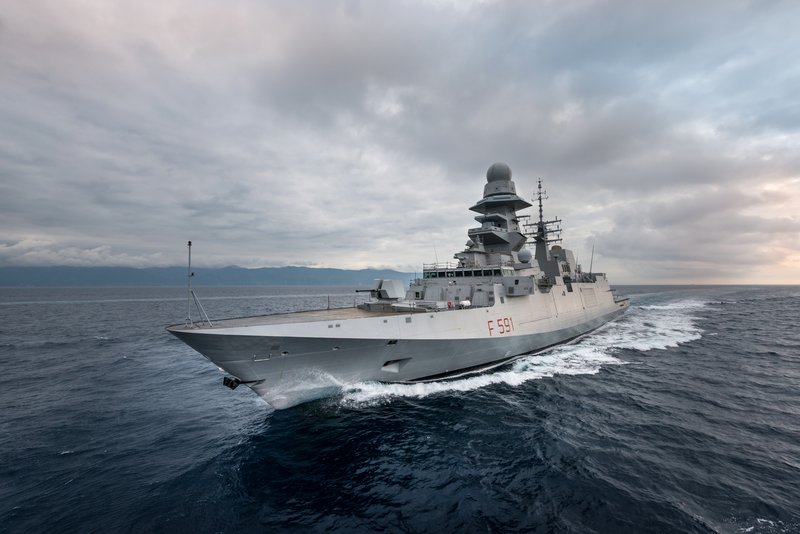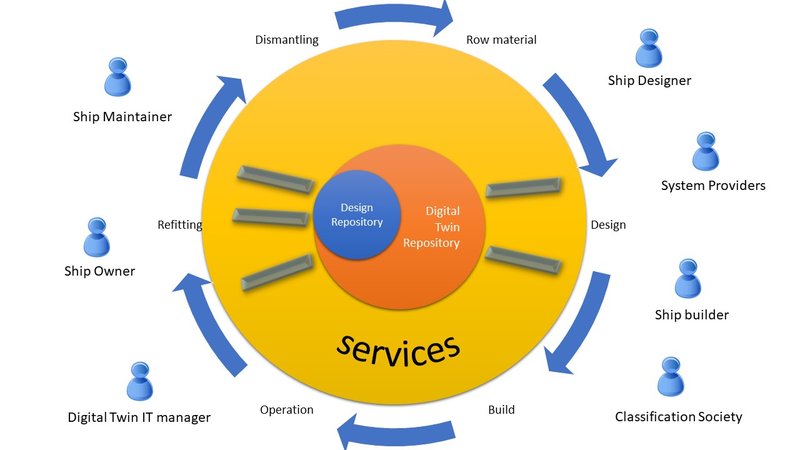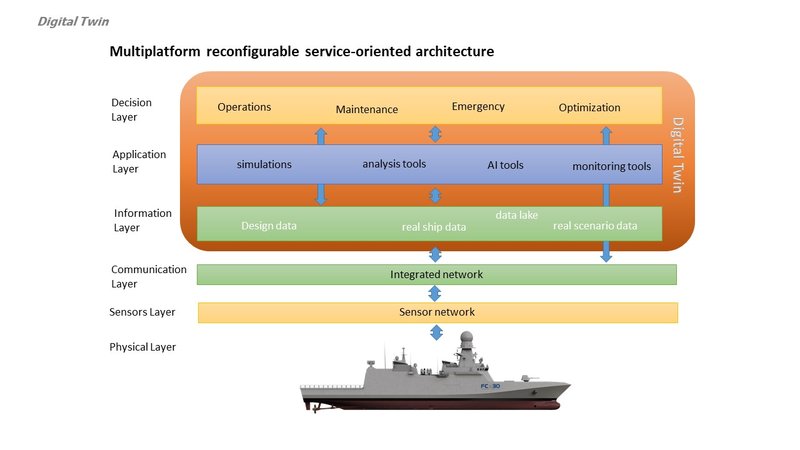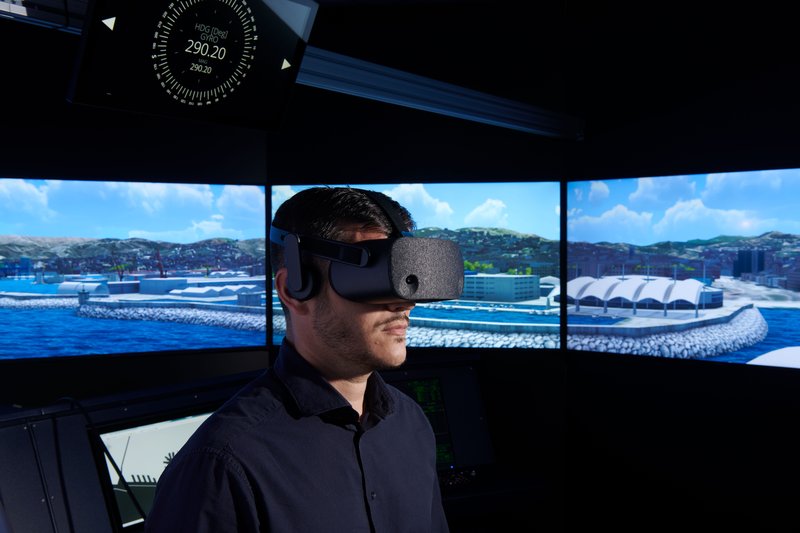Sailing into the Future: Fincantieri’s Digital Twin Revolution
This article is brought to you by Fincantieri
Digital innovation has long been a crucial part of Fincantieri’s story, sharpening our competitive edge in the ship design process. Underscoring our approach is the use of simulation and virtual prototypes, providing an opportunity to check design choices and optimise the final product.
The proliferation of digital components onboard ships, coupled with advancements in computational power and artificial intelligence, has paved the way for a more robust utilisation of simulation knowledge in the operational life of our vessels. This convergence of technologies has forged a path for the Digital Twin- a virtual counterpart that mirrors the physical ship in real time, unlocking a myriad of possibilities to enhance the design process, optimise operational efficiency, and improve predictive maintenance.

The concept of a Digital Twin lies at the heart of fully digitalising the lifecycle of a ship, exemplified through Fincantieri’s integration of tools within the Digital Twin framework of the FCx30. Essentially, a Digital Twin transforms a digital model into a dynamic entity by incorporating real-time data gathered across daily operations. Crucially, seamless integration between digital tools and the ship’s onboard data network is instrumental in constructing an effective and economical Digital Twin.
A Data Driven Approach
Laying the foundations for Fincantieri’s Digital Twin architecture is a data-centric approach that prioritises the collection and analysis of real-time data from onboard sensors and systems. We have leveraged this data to create a suite of Digital Twin services, ranging from operational availability assessments to predictive maintenance and scenario simulations. Moreover, by integrating physics-based models with data-driven insights, we can offer ship operators unparalleled visibility into the DNA of their vessels.

An Adaptable, Scalable, and Resilient Architecture
At the core of Fincantieri’s Digital Twin Architecture is an Information layer, where data and information originating from the physical ship travel through various communication networks and are then stored in a repository known as the Data Lake. This repository employs big data technology, with the capacity to handle vast amounts of information across different forms such as video, binary, text, and audio.
This, in turn, facilitates the retrieval of information for all connected software tools in the Application Layer. These applications can range from legacy software to digitally native software constructed within a service-oriented architecture. By combining activities from multiple applications, the Decision Support layer is equipped with the materials to offer decision-making assistance through various tools including simple dashboards, as well as intricate simulation systems. enabling sophisticated what-if analyses for various investigations such as maintenance, operations, and optimisation.

Building a Bespoke Digital Twin Service
Despite the concept of a complete Digital Twin for a ship being highly ambitious due to its complexity, Fincantieri is instead focusing on developing “Digital Twin ship services.” These services will consist of multiple digital applications or tools that are catered to specific aspects of the ship, such as manoeuvrability, predictive maintenance, and energy management optimisation.
Rather than seeking to replicate the entire ship in digital form, these services would use the Digital Twin to provide forecasting and decision-making support for users, offering a more practical and manageable approach to implementing Digital Twin technology in the maritime industry.
- Operational Availability: The Fincantieri Architecture provides real-time updated on all on-board systems and structures, facilitating the assessment of the ship’s operational capability at any given moment.
- Fatigue Analysis and Structural Assessment: By using sensors on the ship’s structure, the architecture can identify the vessel’s status and performs fatigue analysis, enabling proactive maintenance to prevent damages.
- Scenario Operational Simulations: The Digital Twin of the ship, reflecting its current state, is integrated into complex distributed simulations of operational scenarios.
- Performance/ Energy Monitoring: Using system sensors, onboard radars, and weather forecasts, the architecture optimises ship performance at sea, reducing energy consumption.
- Smart Maintenance: By analysing system time histories, real-time behaviour, weather, and sea conditions, the architecture predicts maintenance needs efficiently, implementing predictive maintenance to prevent damages and reduce costs.
- Design Optimisation: Real data recorded during operations is utilised to extract knowledge for optimising future design options.
- Remote Assistance: Utilising Extended Reality (XR) systems, remote assistance activities are conducted using the digital model of the ship and its systems.
- Training: The Digital Twin is utilised in virtual simulation environments for various training activities, fostering a smarter crew with continuous training opportunities both onboard and ashore.
- Technology Transfer: In cases of system changes, upgrades, or crew turnover, the Digital Twin simulation aids in transferring essential skills for correctly utilising ship systems.
- Risk Analysis & Management: By simulating and assessing operations in the digital realm, the architecture reduces the risk associated with performing potentially hazardous tasks.

Challenges and Considerations
While a Digital Twin is an interesting tool positioned to improve the competitiveness of naval ships in the near future, the development of this technology is not without its drawbacks.
Firstly, the ownership and handling of data remains a significant challenge, alongside the management and knowledge derived from this data. An additional issue is posed by integrating legacy tools, as previous digitalisation efforts may have been unilateral, requiring a comprehensive approach time and space to fully harness the potential of a Digital Twin. A further consideration is ensuring that robust cyber security measures are implemented to safeguard again the vulnerabilities arising from data generation, storage, and exchange.
A crucial component in overriding these challenges is adopting a collaborative and connected mindset, as a Digital Twin fosters a culture of interaction among domains that are usually accustomed to working independently.
As Fincantieri sets sail for one of its most ambitious ventures yet, we are addressing these challenges in our implementation of a more comprehensive digital ship architecture, which will serve as a platform for Digital Twin services both onboard and ashore. Ultimately, the Digital Twin is poised to serve as a vital tool for managing ships and extracting knowledge from the field, thereby optimising design and logistic support for current and future Fincantieri vessels and fortifying our position at the forefront of the Maritime industry’s digital transformation.
More from Industry Spotlights
-
![“Adversaries have adapted”: how counter-UAS and space control will decide future conflicts]()
“Adversaries have adapted”: how counter-UAS and space control will decide future conflicts
In conversation... EOS's Andreas Schwer talks to Shephard's Ben Watts about how the Australian company is shifting its strategic focus to two technologies it sees as essential for success on the modern battlefield - C-UAS and space control.
-
![Tiltrotor: The Long-Range Maneuver Solution]()
Tiltrotor: The Long-Range Maneuver Solution
If competition turns to conflict, the United States, along with its allies and partners, must be prepared to confront peer and near-peer competitors capable of achieving parity in military capability.
-
![Introducing the MITR-M1 Half Mask: Tactical respiratory protection for every scenario]()
Introducing the MITR-M1 Half Mask: Tactical respiratory protection for every scenario
Counter terrorism, specialist firearms officers, special forces, explosive breaching, drug interdiction, riot control, indoor/outdoor shooting, environmental disaster response, first response, prisons and corrections: tactical operators across law enforcement, first responders, and the military face a vast array of low-mid level respiratory threats in their day-to-day operations.
-
![Need to develop AI-powered red pictures for battlefield situational awareness?]()
Need to develop AI-powered red pictures for battlefield situational awareness?
Leverage Systematic's SitaWare suite to fuse intelligence and share awareness of your opponent’s deployments and capabilities.
-
![Sustain capabilities and secure advantage with advanced Digital Engineering]()
Sustain capabilities and secure advantage with advanced Digital Engineering
CDS Defence & Security optimises defence systems with Digital Engineering and MBPS for peak performance. Learn more today!
-
![Solving production & supply chain challenges with additive manufacturing]()
Solving production & supply chain challenges with additive manufacturing
Boosting supply chain resilience with additive manufacturing: exploring solutions to production and logistics challenges.
























